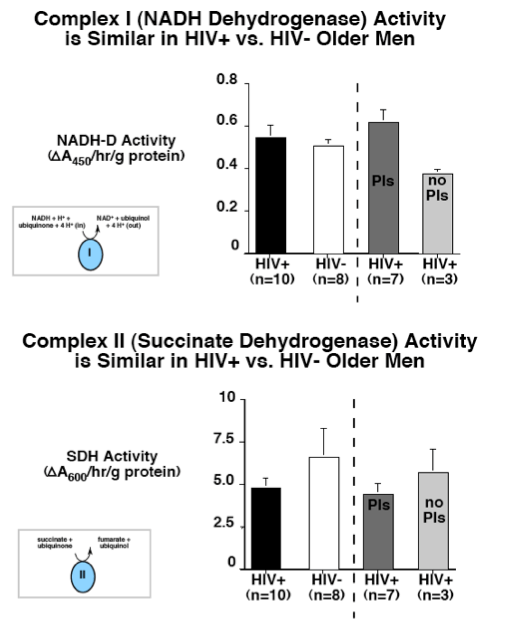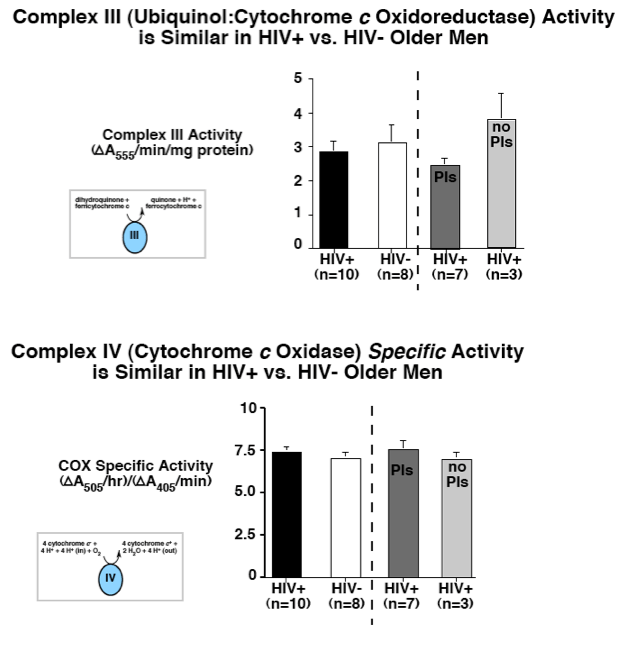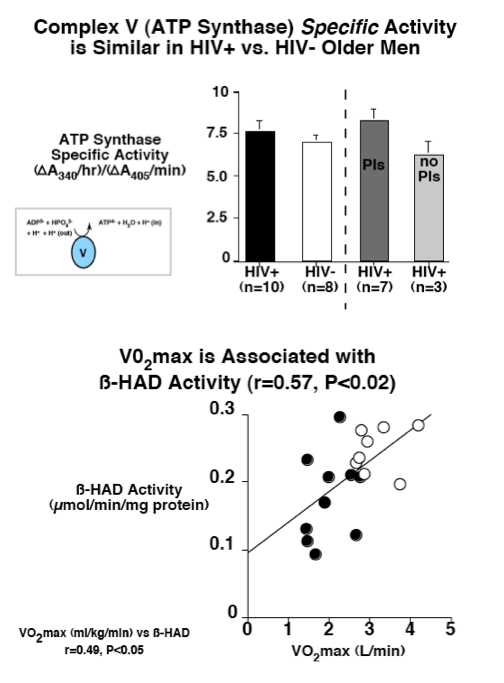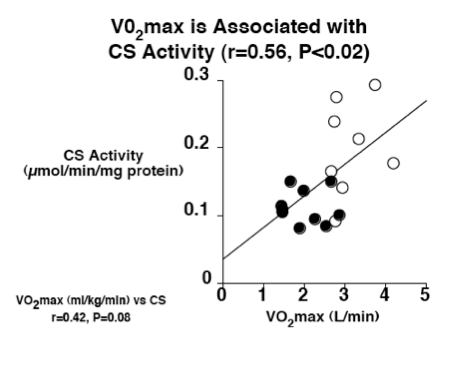 |
 |
 |
| |
Reduced skeletal muscle mitochondrial function in older HIV-infected men is associated with low aerobic exercise capacity
|
| |
| |
Download the PDF here
Reported by Jules Levin
IAC 2012 July 22-27 Wash DC
See attached pdf, published study reporting exercise improves muscle mitochondria & aerobic capacity in men 65 yrs old.
Heidi Ortmeyer1, Alice Ryan1, Charlene Hafer-Macko2, KrisAnn Oursler1
Baltimore Veterans Affairs Medical Center, Geriatric Research, Education, and Clinical Center
University of Maryland School of Medicine, Departments of Medicine1 and Neurology2
From Jules: aerobic capacity is reduced in older HIV+ men, this study finds, and this is associated with mitochondrial function, and this is likely associated with not exercising enough, in other words exercise is likely to improve aerobic capacity & mitochondrial function.
"These findings support the possibility that exercise training will increase aerobic capacity and improve mitochondrial oxidative function in older HIV-infected adults, comparable to changes seen with exercise in HIV negative adults."
CONCLUSIONS
· Only ß-HAD and CS activity are lower in men with HIV compared to men without HIV. Neither
ß-HAD nor CS are encoded by mtDNA.
· Reduced ß-HAD and CS activity are associated with lower VO2max in older men with HIV.
· Our results suggest that aerobic exercise training will be sufficient to improve mitochondrial function in
older men with HIV regardless of HIV therapy.
Reduced skeletal muscle mitochondrial function in older HIV-positive men is associated with low aerobic exercise capacity
H. Ortmeyer1,2, A. Ryan1,2, C. Hafer-Macko2,3, K. Oursler1,2
1University of Maryland School of Medicine, Medicine, Baltimore, United States, 2Baltimore Veterans Affairs Medical Center, Geriatric Research, Education, and Clinical Center, Baltimore, United States, 3University of Maryland School of Medicine, Neurology, Baltimore, United States
ABSTRACT
Background: We previously reported a 40% reduction in aerobic capacity in older (50+ years) HIV-infected men. Impaired skeletal muscle oxidative function is a determinant of poor aerobic capacity, but can improve with exercise training. The objective of this study was to compare skeletal muscle mitochondrial enzyme activity between older HIV-infected and negative men, and determine the relationship to aerobic capacity.
Methods: This cross-sectional study included 10 HIV-infected men on NRTI-based therapy with either protease inhibitors (n=7) or efavirenz (n=3) and eight age and BMI-matched HIV negative men. We measured aerobic capacity (peakVO2) and body composition (DXA, CT). Skeletal muscle samples were collected by needle biopsy of the vastus lateralis. Enzyme activity assays for mitochondrial function including fatty acid oxidation (acyl-CoA synthase, carnitine palmitoyltransferase, and ß-hydroxyacyl CoA dehydrogenase [ß-HAD]), oxidation (citrate synthase [CS]), and oxidative phosphorylation (electron transport chain [ETC] complexes I,II,IV, and V) were performed in muscle homogenates prepared from lyophilized microdissected muscle.
Results: Age (mean 55 years), BMI (mean 28 kg/m2), total lean mass and mid-thigh muscle area were similar between groups (p>0.1). HIV-infected men had lower total fat mass and visceral adipose tissue (p▓0.05). PeakVO2 was 33% lower in HIV-infected men compared to HIV negative men (mean ▒SE; 25 ▒3 vs. 33 ▒1 mL/kg/min, p< 0.01). ß-HAD and CS activity (Ámol/min/mg protein) were significantly lower in HIV-infected men compared to HIV negative men (Figure 1) and correlated significantly with peakVO2 (Figure 2). There were no differences in ETC enzyme activities between the two groups.

Conclusions: Older HIV-infected men on modern therapy have intact ETC skeletal muscle enzyme activity, but reduced oxidative enzyme activity, which is significantly associated with low aerobic capacity. These findings support the possibility that exercise training will increase aerobic capacity and improve mitochondrial oxidative function in older HIV-infected adults, comparable to changes seen with exercise in HIV negative adults.
OBJECTIVES
· To compare skeletal muscle mitochondrial function in older men with and without HIV
· To determine whether mitochondrial dysfunction is associated with reduced aerobic capacity and/or drug therapy in older men with HIV
BACKGROUND
ATP
· transfers energy from chemical bonds to cellular reactions that require energy
(ATP==>ADP + energy + Pi)
· formed in mitochondria by oxidative phosphorylation
· 70 kg man produces 40 kg of ATP/day
· energy yield from 1 g of stored triglyceride is over 5X > than from 1 g stored glycogen
( ▄ from Molecular Biology of the Cell)


Effects of Nucleoside Reverse Transcriptase Inhibitors (NRTIs) and Protease Inhibitors (PIs)
on Mitochondrial Function in Vitro
- NRTIs decrease SDH and COX activities (Benbrik et al, 1997).
- PIs reduce fatty acid oxidation (14-C) and CPT-1 protein expression in mouse C2C12 muscle
cells (Richmond et al, 2010).
Hypothesis
Older men with HIV will have significantly lower activity of enzymes involved in fatty acid oxidation
(ACS, CPT-1, ß-HAD), oxidation (CS), and oxidative phosphorylation (Complex I, II, III, IV and V)
compared to age and BMI-matched controls.

METHODS
· Skeletal muscle (vastus lateralis) was lyophilized and microdissected before assay
· Samples from HIV+ and HIV- individuals were run in the same assay
· All nine enzyme activity & protein assays were performed in the same homogenate
· ACS & CPT-1 assays require radioactive substrates - products were extracted and determined by scintillation counting
· ß-HAD, CS and Complex I-V activities were measured by continuous spectrophometric rate
· Complex IV and V protein were measured by microplate assay
· Enzyme activity was corrected by total protein (Bradford assay) or enzyme specific protein
· Intramuscular TG was determined after lipid extraction by colorimetric asssy
· ATP was measured by bioluminescence assay






|
| |
|
 |
 |
|
|